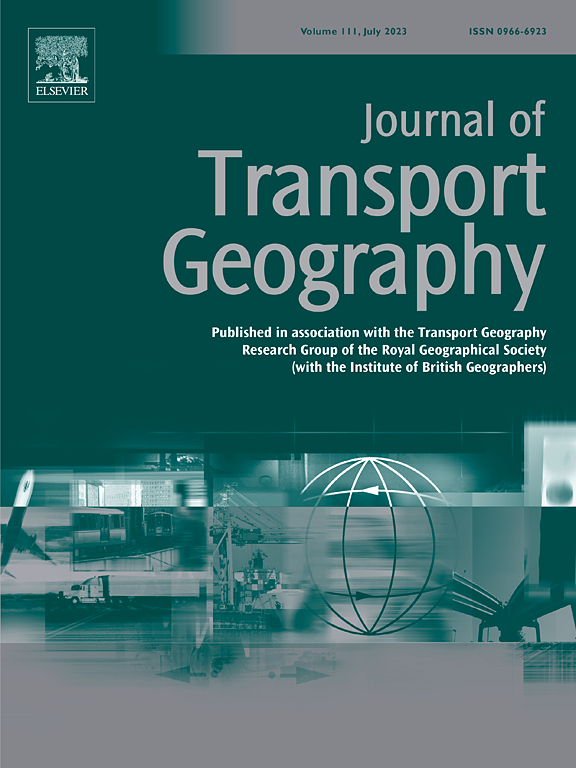A quasi-experimental study of light rail transit on jobs-housing balance by regional typology: A case study of South Korea
IF 5.7
2区 工程技术
Q1 ECONOMICS
引用次数: 0
Abstract
Light Rail Transit (LRT) systems have been introduced across various regions of South Korea to address travel needs and promote sustainable urban development. Jobs-housing balance was one of the top priorities for city management in these schemes. However, a lack of an integrated plan for LRT and jobs-housing opportunities has resulted in excess commuting, which contradicts the expected outcome of providing an LRT system. Existing literature has reported mixed findings on jobs-housing balance. These seemingly perplexing results would arise from methodological limitations that fail to adequately control for confounding variables and explain variations among regional types. The study analyzes changes in jobs-housing balance after the intervention of LRT systems in different urban contexts. This study categorizes regional typologies of LRT service areas into three types—type1 if a line connects “periphery-metropolitan center-periphery” areas; type2 if a line connects “city center-periphery”; type3 if a line serves “metropolitan center.” The study employs a quasi-experimental design incorporating propensity score matching (PSM) and difference-in-difference regression. PSM matches treatment and control groups that have similar characteristics. Subsequently, difference-in-difference regression modeling estimates the treatment effects on jobs-housing balance resulting from LRT system operations. The PSM results confirm the varied impacts of LRT operations on the jobs-housing balance depending on the different regional types. Types 1 and 2, linking the metropolitan or surrounding city centers with the urban peripheries, experience significant imbalances, while the control groups show greater jobs-housing balance after the introduction of LRT. However, type 3 serving metropolitan centers demonstrates no significant difference between treatment and control groups. The DID results indicate that the treatment effect is only significant in type 1. In conclusion, LRT systems, which mainly connect urban peripheries and centers, are more likely to cause a mismatch between jobs and housing distribution. The results suggest an integrated approach between LRT and the built environment, such as transit-oriented development (TOD), that promotes a jobs-housing balance by locating jobs and affordable housing near LRT stations.
基于区域类型的轻轨交通对职住平衡的准实验研究——以韩国为例
轻轨交通(LRT)系统已在韩国各个地区引入,以满足出行需求并促进城市可持续发展。在这些方案中,工作与住房的平衡是城市管理的首要任务之一。然而,缺乏对轻轨和工作住房机会的综合规划导致了通勤过剩,这与提供轻轨系统的预期结果相矛盾。现有文献报道了关于工作与住房平衡的不同发现。这些看似令人困惑的结果可能是由于方法学的局限性,未能充分控制混杂变量并解释区域类型之间的差异。本研究分析了不同城市背景下轻轨系统介入后职住平衡的变化。本研究将轻轨服务区的区域类型划分为三种类型:type1,如果一条线路连接“外围-大都市中心-外围”区域;Type2,如果有一条线连接“城市中心-外围”;如果线路服务于“大都市中心”,则输入3。本研究采用准实验设计,结合倾向得分匹配(PSM)和差中差回归。PSM匹配具有相似特征的治疗组和对照组。随后,采用差分回归模型估计了轻轨系统运行对职住平衡的影响。PSM结果证实了轻轨运营对职住平衡的不同影响取决于不同的区域类型。类型1和类型2,连接大都市或周边城市中心与城市外围,经历了显著的不平衡,而控制组在引入轻轨后表现出更大的工作-住房平衡。然而,服务于大都市中心的3型在治疗组和对照组之间没有显著差异。DID结果表明,治疗效果仅在1型中显著。综上所述,主要连接城市边缘和中心的轻轨系统更容易造成工作和住房分布的不匹配。研究结果建议将轻轨与建筑环境相结合,如以交通为导向的发展(TOD),通过在轻轨车站附近定位工作和经济适用房,促进工作与住房的平衡。
本文章由计算机程序翻译,如有差异,请以英文原文为准。
求助全文
约1分钟内获得全文
求助全文
来源期刊

Journal of Transport Geography
Multiple-
CiteScore
11.50
自引率
11.50%
发文量
197
期刊介绍:
A major resurgence has occurred in transport geography in the wake of political and policy changes, huge transport infrastructure projects and responses to urban traffic congestion. The Journal of Transport Geography provides a central focus for developments in this rapidly expanding sub-discipline.
 求助内容:
求助内容: 应助结果提醒方式:
应助结果提醒方式:


